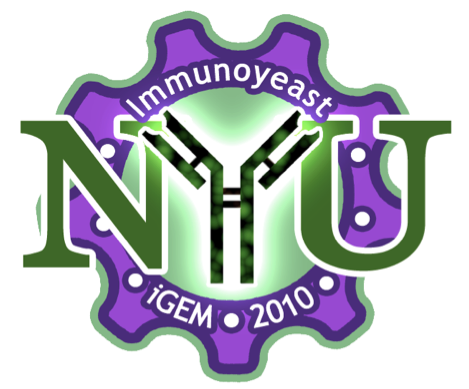Team:NYU/Project
From 2010.igem.org

Our goal is to use the tools of synthetic biology to make a biological machine capable of antibody discovery. To do this, we have decided to learn from our own immune system by porting its own antibody discovery strategies into an engineered strain of yeast. This yeast will be capable of screening a library of antibodies against a target antigen, recombining the antibody gene in vivo and then either secreting or surface displaying the resulting antibody protein for a variety of purposes. Our hope is to demonstrate the feasibility of using the yeast cell not only as a vessel for antibody discovery but as a streamlined processing unit that can discover and also begin production of new antibodies - all in one test tube!
Project Details
Our game plan for this year's competition is to construct an easy-to-use yeast strain capable of intracellular antibody discovery. The current dominant mode of microbial antibody discovery requires cellular surface display and high-throughput fluorescent screening. Instead of using this method, we wanted our cells to be able to sense if the antibody they are translating will bind the target antigen. Using a modified form of the yeast two-hybrid screening system, the yeast cells will sense the amount of antibody::antigen interaction because it will increase the level of transcription of a reporter gene. If this gene encodes a nutritional marker, such as Ura3, only cells experiencing antibody:antigen interactions will grow in selective media (i.e. without the nutrient such as Uracil). Using this method the original population of our yeast strain will be able to, in essence, screen itself and our resulting yeast population will contain only antibodies that bind our antigen.
In a research setting, once you have discovered the antibody you wish to use you must then reclone the gene for it into a secretion vector for production of pure antibody protein. This involves taking the plasmid out of the yeast cell, excising the antibody gene, ligating it into the second vector and then transforming it back into a suitable yeast strain. To make this process faster and more easily accomplished, we have incorporated a recombination-based architecture into our system that will allow the cells to modify the antibody plasmid in vivo. Using this system transcription of the antibody gene can go straight from screening to protein production in a matter of minutes. This concept has the capability to not only shave weeks off of current antibody discovery protocols, but opens the door to cellular programming for other methods, such as restructuring of antibody genes or performing more complex screenings for different purposes.
The Experiments
In the spectrum of molecular biology, iGEM is a very short time frame. Because of this short time frame, our wet lab team having only two members and our extremely limited research budget, we felt that radical simplification of our experiments would allow us to demonstrate the feasibility of our ideas without requiring resources we simply did not have. Because many of the individual aspects that this project has brought together have been investigated with success, we were able to perform some experiments using proxies for the 'real thing'.
 "
"

